
Sign up to save your library
With an OverDrive account, you can save your favorite libraries for at-a-glance information about availability. Find out more about OverDrive accounts.
Find this title in Libby, the library reading app by OverDrive.



Search for a digital library with this title
Title found at these libraries:
| Library Name | Distance |
|---|---|
| Loading... |
The Theory and Practice of Creative Coaching has been long in development and is not meant as an end-view of creativity in this field. It is, however, a stimulating collection of ideas (with detailed views from both practice and education) that seeks to provide stimulus to trainee coaches as well as those whose practice is well-established. With topics as wide-ranging as walking to line-drawing this book seeks to change the practice of practitioners, new and old, and helps to articulate the ways in which David Clutterbuck has called for a move from the use of models towards mastery by embracing new ways of working with the clients of coaching. With a wide-ranging scope, examples, ideas and a strong link to academic understanding, this book will provide a stimulus to the coaches, supervisors and educationalists to open their eyes to alternative ways of practicing their craft.
|The Theory and Practice of Creative Coaching is a book that seeks to unearth new and exciting ways of coaching individuals in organisations and communities generally. Much of the practical writing about coaching is dominated by the use of coaching models and approaches and less work has been undertaken exploring the human basis for this work. Taking its source of inspiration from a wide range of sources such as philosophy and the practical joys of nature this book will seek to fill some gaps in the ways in which practice unfolds.
Much of work undertaken has been against the practical backdrop of pitching theory against practice . In addition, more recently, this is set against trends involved in Higher Education whereby mature adults are undergoing over 12 months of training to achieve the nationally recognised ILM coaching qualifications at Levels 5 and 7. This represents contact with a diverse set of cohorts of learners of over 300 students in the past 5 years for more than 100 contact hours per cohort. Mixing theory with practice is one of the strong points of these vocational qualifications 'producing' highly motivated practitioners forging their understanding in the fulcrum of reflective practice and individual reflexivity.
Against this backdrop ideas, concepts and new ways of thinking have produced groups of coaches who are adept at utilising core and fundamental aspects of human nature to become successful coaches. Huge shifts in understanding have been made through engaging in creative activities; to engaging in art, metaphors, nature, walking and unusual methods of engagement with a fellow human in a coaching setting. As a result, this book sheds light upon the use of creative techniques and begins to extend the possibilities for coaches and their clients. Pitched as a way in which peers and equals can work together to learn and develop alternative coaching approaches this book forms the platform for strong learning and an increased diversity of practice and understanding.







